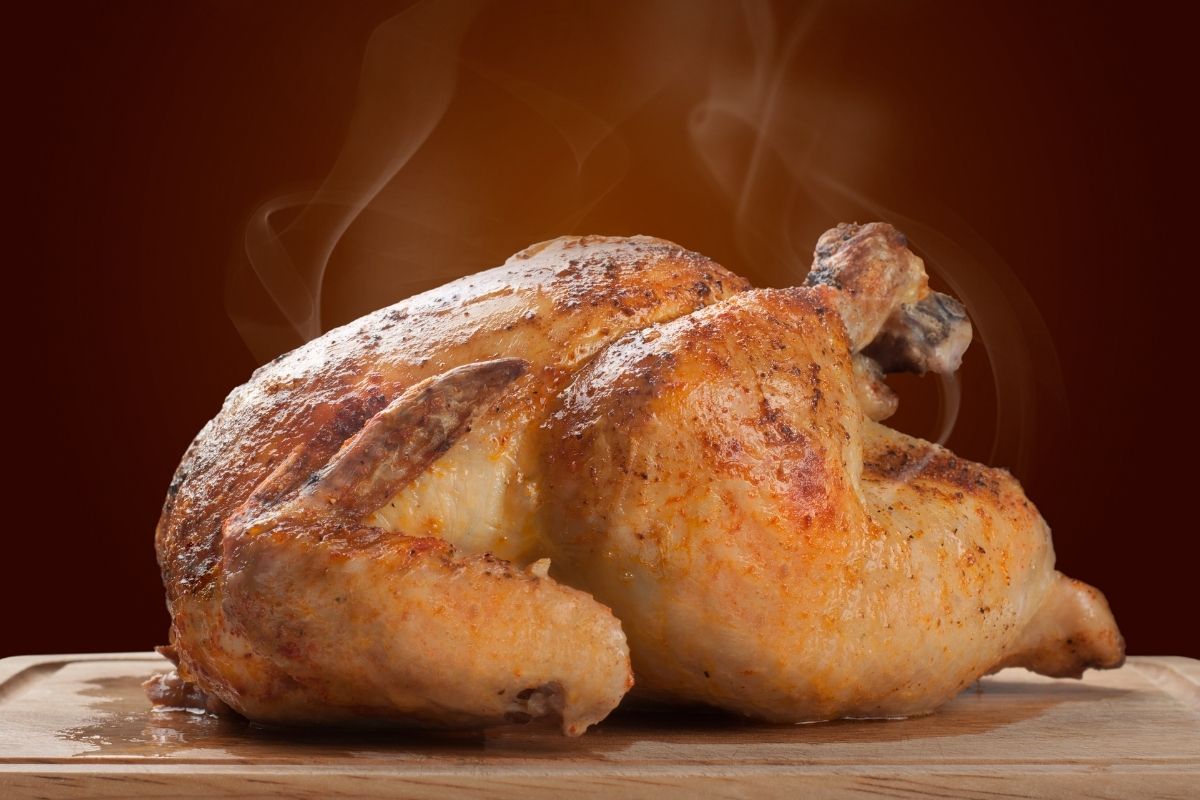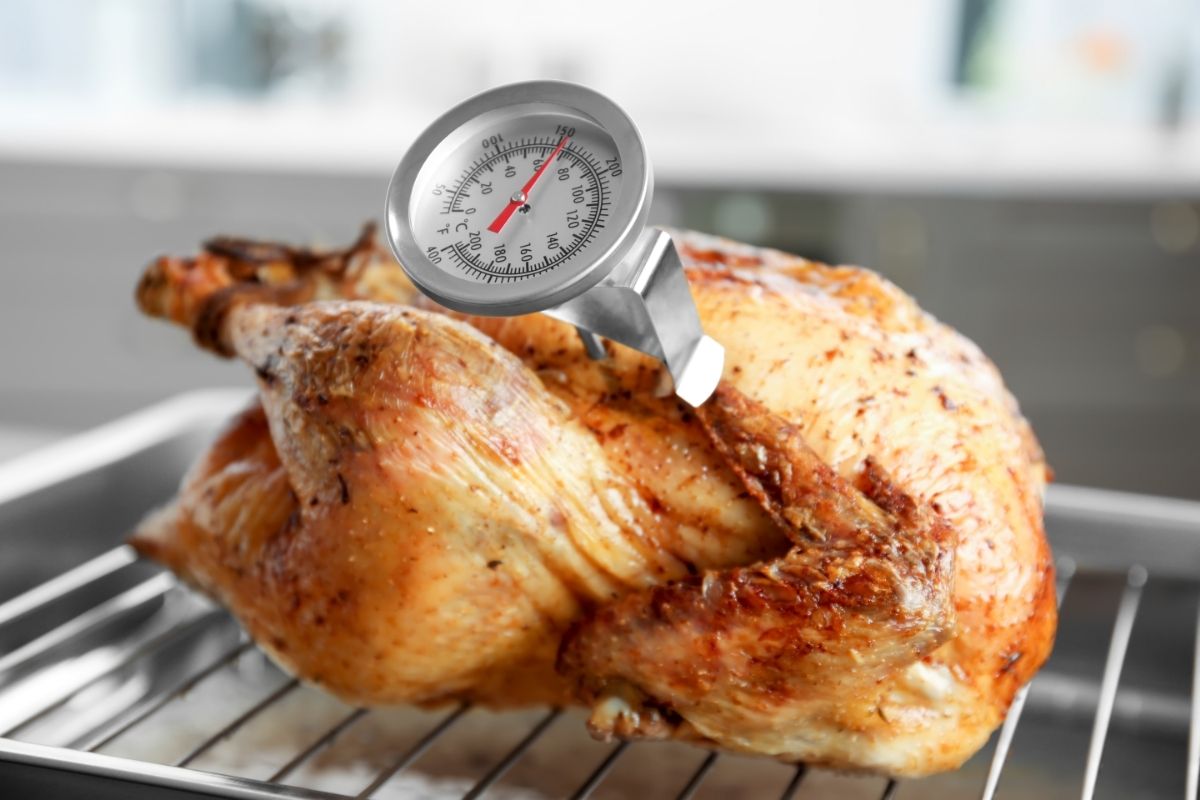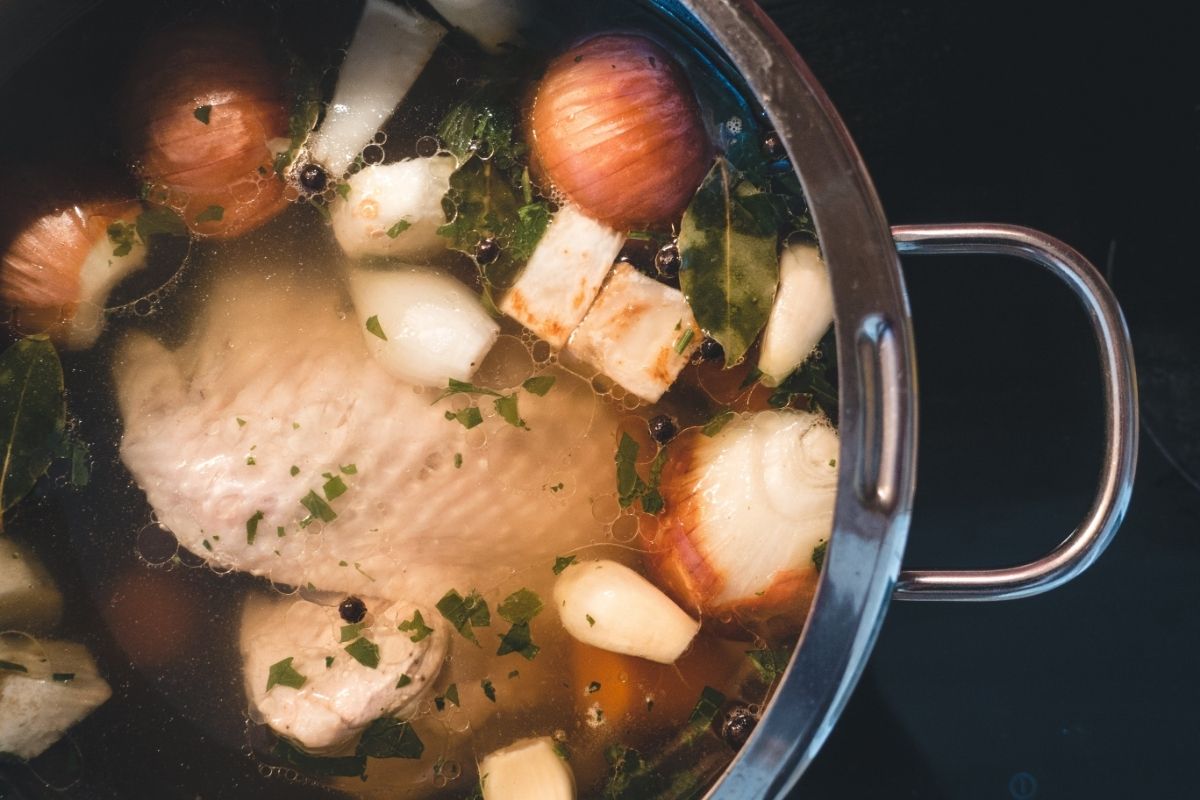Chicken is a really popular protein that a lot of people like to eat. It is also a versatile meat that can be used in a lot of meals.
However, one thing that you should know about chicken, is that it has the potential to become rubbery if not cooked properly.

The main reason why this happens is because of the proteins in the chicken. The proteins are what makes up the muscle fibers and connective tissues in the chicken.
When these proteins get heated too much, they start to break down and create a gel-like substance.
This gel-like substance is called “myosin”, and it is what makes the chicken feel rubbery when it gets overcooked.
In this article, we are going to go into detail why your chicken may be rubbery. We will be discussing the causes and how you can avoid it, so that you have perfect chicken every time.
Causes Of Rubbery Chicken
There are a couple of reasons as to why your chicken may end up being rubbery. These are:
Cooking Time
When cooking chicken for long periods of time, the myosin starts breaking down and creating a gel-like substance inside the chicken.
This is mainly caused by the high heat levels that are applied to the chicken.
If you cook the chicken for longer than 30 minutes at 350 degrees Fahrenheit, it will most likely become rubbery.
If you overcook your chicken, it will cause the chicken to become rubbery. The reason behind this is that the myosin breaks down even more during the process of cooking.
So if you cook the chicken past its prime, then it will definitely turn out to be rubbery.
Undercooked
It is important that your chicken has reached a safe internal temperature, before you start eating the chicken. If your chicken is rubbery, then it may be undercooked.
However, uncooked chicken can be really dangerous if consumed.
This is due to the fact that the bacteria is still on the chicken.
If your chicken doesn’t reach the required internal temperature then the bacteria will still be there, and if consumed this could lead to food poisoning.
The best way to make sure that your chicken isn’t uncooked is by using a thermometer.
You should test the chicken in the thickest part, as this area will take longer to cook than the thinner parts.
As long as your chicken has been cooked to 165 degrees, then you can safely eat the chicken without fear of food poisoning.
Also, you will notice that the chicken is no longer transparent and has lost its rubbery texture.
Not Storing Properly
If you don’t store your chicken properly, then it could potentially end up becoming rubbery. The reason for this is that once the chicken is stored, it loses moisture.
This means that there is less water in the chicken, which allows the myosin to break down faster.
Moisture
Sometimes, chicken is dry because it has lost all its moisture. This can then lead to a rubbery chicken.
As there is no way to tell whether the chicken you have brought will lack moisture, you will need to try to keep it as moist as possible during the cooking and preparation.
Bringing your meat before cooking, or using a marinade, can help add more moisture to your chicken.
However, try not to do this step for too long or your chicken could become either too mushy or if it’s exposed to acidic for too long will dry it out more.
Woody Breast
Another thing that can cause your chicken to be rubbery is when you use woody breast.
This happens because the muscle fibers in the meat are too tight, in some instances the fibers are actually knotted together.
This then gives your chicken a rubbery texture after it has been cooked.
Around 5 to 10% of chickens in America are said to suffer from woody breasts. This is believed to be more common among organic chickens.
Yet, some experts also believe that this could be a genetic issue as well.
Woody breast isn’t harmful to eat, but it doesn’t make the meat very appealing to eat either due to the texture it gives.
Woody breasts are typically very firm to the touch, and sometimes there are noticeable hard lumps.
However, the positives is that woody breast only affects chicken breasts, so the rest of the chicken will be completely fine.
How To Prevent Your Chicken From Being Rubbery
Now that we know what causes our chicken to become rubbery, let’s talk about how to prevent it from happening. There are two ways that you can do this.
One way is by using the right temperature, while the other way is by storing your chicken correctly.
Yet there are some other ways as well. Below we have put all the ways you can try to prevent rubbery chicken from occurring.
Temperature

One of the best ways to make sure that your meat doesn’t get rubbery is to heat it at the correct temp.
When you’re making a roast chicken, you want to make sure that you cook it at 180 degrees Celsius, or 350 degrees Fahrenheit.
This is the minimum temperature needed to kill any bacteria present in the chicken. If you don’t cook it at this temp, then you risk getting food poisoning.
You can check the internal temp of your chicken by inserting a thermometer into the thickest part of the thigh.
Make sure that you insert the thermometer straight through the skin, and not just under the skin.
Once inserted, leave it there until the chicken is ready. Then remove the thermometer and place it in a bowl of ice-cold water.
Leave it in there for around ten minutes. After ten minutes, take the thermometer out and see how hot it is.
Ideally, the internal temp should be 165 degrees Fahrenheit. If it isn’t, then you need to cook it longer.
Storage
The second way to avoid your chicken being rubbery is to store it correctly. This includes keeping it away from direct sunlight, extreme temperatures, and humidity.
These things can all affect the quality of your chicken, and therefore the quality of the meat itself.
If you store your chicken in the sun, then it will lose moisture. This means that it will start to dry out.
This makes it harder for the myosin to form, and therefore the meat won’t hold up as well. The ideal way to store your chicken is to keep your chicken in the fridge.
If you store your chicken in extremely high temps, then it will dry out quicker than normal. This is because the proteins in the meat will denature.
Denaturing means that they stop moving like they normally would, and therefore they won’t be able to contract properly.
So when you cook your chicken, the muscles won’t tighten up as much, and therefore the meat will be less tender.
More Oil
Use more oil while cooking at a lower temperature. This way, you can properly control the cooking of your chicken.
You can cook it slowly but also to the right temperature without drying your chicken out at the same time.
If you are grilling, then a neutral oil like canola oil is a great option to use here. With some lean cuts of chicken, you can put a thin layer of oil onto the chicken itself.
However, with this extra oil you need to be careful when cooking because it could spit back at you, especially if the chicken is being cooked at a high heat.
Covered Up
While the chicken is marinating, then it should be covered up. Even while you wait for either your grill, pan, or oven to heat up, you should keep your chicken covered up.
Alongside that, once your chicken is cooked and resting, make sure it is covered up.
By keeping your chicken covered up, you are reducing the chances of the chicken drying up and becoming rubbery.
How To Save Rubbery Chicken
You have noticed that your chicken has become rubbery, don’t be disheartened, there is a way to save it.
Chicken Broth/Stock

You can try to soften the chicken, by reheating it in a broth. A chicken broth or stock is ideal.
Pour some of this substance into a baking dish and slice up your rubbery chicken. Then add the chicken to your baking dish.
Add your chicken to a 300-degree oven, and leave it in there for 10 to 15 minutes. This should help to add moisture to your chicken and reverse the rubbery texture.
Sauce
If you have overcooked chicken which has turned rubbery, then we would suggest basting the chicken in any sauce of your choosing. This could be BBQ or tomato sauce.
Not only will you be adding more moisture back into your overcooked chicken, but you will be adding more flavor to your chicken as well.
Sandwiches Or Salads
If you find your chicken is rubbery, then slice it up and use it for sandwiches instead. You will not notice the rubbery texture when it is combined with other ingredients.
Yet, try to use soft bread, so that you don’t notice the chewy nature of the rubbery chicken.
If you aren’t keen on sandwiches, you could slice up your chicken and add it to a salad. The soft lettuce, tomatoes, cucumber, and the dressing will give the chicken some extra moisture.
This will make it more enjoyable to eat, while also adding more flavors to the bland chicken.
Is It Safe To Eat Rubbery Chicken?
Of course, you can eat rubbery chicken. However, the only time you should be cautious about eating rubbery chicken, is if it is rubbery due to being uncooked.
As long as your chicken has been cooked to the correct temperatures, then the rubbery chicken should be dangerous to eat.
Otherwise, you can eat rubbery chicken, but you may not enjoy it. This is due to rubbery chicken not having a pleasant texture.
Will Organic Chicken Be More Or Less Likely To Be Rubbery?
Organic chickens are usually raised in better conditions than non-organic ones. They are fed organic feed, and they are kept in clean environments.
Therefore, they are more likely to be free of diseases such as salmonella than their conventional counterparts.
If you want to buy organic chicken, then make sure that you get it from reputable sources.
However, organic chickens do have more freedom, so they get a lot more exercise.
As a result, the chances of your chicken being tough and rubbery is more likely. Yet, there are ways to combat this.
The main way being to cook the meat for longer at a lower temperature. You should factor in this longer cooking time while cooking.
Final Thoughts
Sometimes rubbery chicken is just out of our control, and it can’t be helped.
You should always be aware of the chicken that you are buying, as sometimes you can see if there is something wrong with it.
Woody breast and white striping are two factors that you will see that you will know will make your chicken rubbery. However, overcooking and uncovering can also cause a rubbery chicken.
The best way to prevent this is to keep the chicken moist and cook it properly.
In this article, we have given you all the tips that you need for discovering the cause of your rubbery chicken and how to prevent it as well.
Now the next time you come across rubbery chicken, you will know what to do. Yet also with any chicken you will now know how to prevent it from becoming rubbery too.
Thanks for reading!
- The 9 Best BBQ Grills for Smoking Brisket - December 29, 2022
- 6 Mouth Watering Grilled Shrimp Recipes - September 16, 2022
- 6 Delicious Grilled Desserts - September 16, 2022
